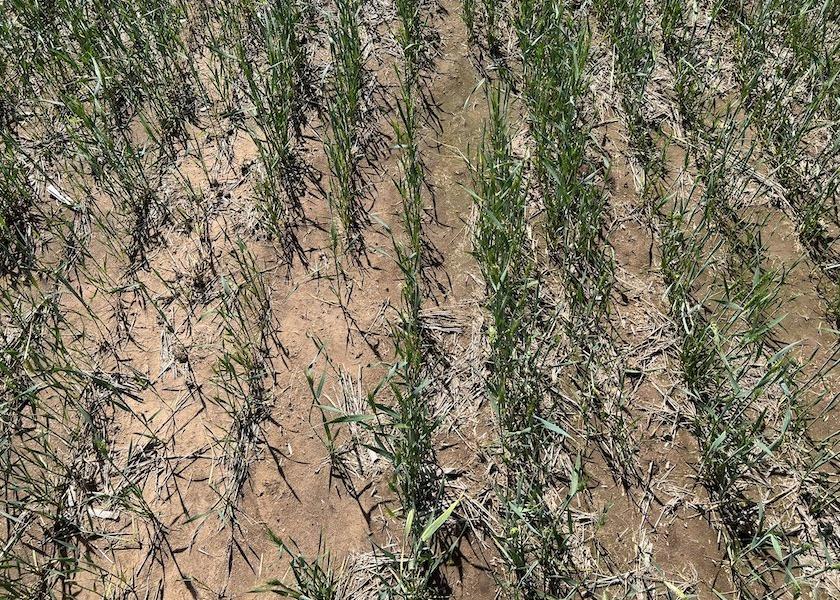Wheat Tour Finds Drought, Freeze Robbed More Wheat Than Expected, Surprisingly High Abandonment Now Pegged Across Kansas

As scouts set out on the 2023 Wheat Quality Council’s Hard Winter Wheat Tour across Kansas this week, they knew they’d found drought-ravaged fields. But as freeze damage became more apparent in the central part of the state, the tour found a disappointing state-wide yield and higher abandonment compared to what USDA currently has penciled in.
The Wheat Tour found a three-day average calculated yield of 30 bu. per acre, but that yield is only based on the field that will be harvested. Kansas Wheat points out crop abandonment will be high, robbing the state’s yield potential and producing a high number of abandoned wheat fields.
Wheat field in Kingman Co KS looking OK from the road but fairly thin as you walk into it. Still better potential than many fields that we’ve sampled today. @KansasWheat @KStateAgron #wheattour23 pic.twitter.com/iAL378gwJe — Romulo Lollato (@KSUWheat) May 17, 2023
Overall, the Wheat Quality Council’s Hard Winter Wheat Tour found:
- The official tour projection for the total production of wheat to be harvested in Kansas is 178 million bushels
- Tour participants thought abandonment might be quite a bit higher than normal at 26.75%.
- The production number is the average of estimated predictions from tour participants who gathered information from 652 fields across the state.
- Based on May 1 conditions, NASS predicted the crop to be higher at 191 million bushels, with a yield of 29 bushels per acre and abandonment at 18.5%.
First-Hand Look From the Field
Tanner Ehmke, who’s the lead economist for grains and oilseeds for CoBank, was on the Wheat Quality Council’s tour this week. He says abandonment is still the biggest question mark for the winter wheat crop across the Plains.
“There's a lot of concern on the tour about abandoned, and that seems to be the wildcard because we saw a lot of good fields or decent fields, we'll say, in the central or eastern part of the state. But as you head further west, conditions rapidly deteriorate. And then we saw a lot of fields that are going to get abandoned,” Ehmke told AgriTalk host Chip Flory during the AgriTalk PM on Thursday.
Abandoned fields and low yields underscore #WheatTour23 - Projection of wheat to be harvested is 178 mb, indicating that tour participants thought abandonment might be high at 26.75%. The yield for the fields that will be harvested was 30 bushels per acre. https://t.co/KuuDcq8aSt pic.twitter.com/h25TgSLB54 — KansasWheat (@KansasWheat) May 18, 2023
Ehmke says he talked to one wheat grower in Sterling, Kansas who is still debating on how much of his crop he’ll harvest this year.
“He said if you look at your insurance rate, and the indemnity check that some will be getting, it just doesn't make any sense for a lot of these fields to be harvested,” Ehmke told Flory on AgriTalk. “So, what we saw out in the field absolutely confirmed, what we had been hearing in the marketplace, it also supports a lot of what USDA said.”
Ehmke says the final tour numbers came in below USDA’s current crop estimate, with the Wheat Tour estimating Kansas’ crop at 178 million bushels, which is more than 13 million bushels below the current USDA estimate.
“We are anticipating a little bit of a smaller crop there. And that's mostly due to a higher abandonment rate. We came in with a yield just a tad bit over USDA. Our yield was 30 bushels an acre and USDA was about 29,” says Ehmke.
Wheat Tour Day 2 - Black Team - West Central - Grainfield (30 mi south)
Adequate moisture, boot stage, Vp stand/ highly variable, no disease. Abandonment
Yield estimate - 4#CattCropTour23 #wheattour23 @KansasWheat #wheat @KSUWheat @KStateAgron @KSU_Shawn pic.twitter.com/sZ0rMJsUF2 — Corbin Catt / Catt & Crew Farms (@cb_catt) May 17, 2023
Freeze Damage Deals Wheat a Double Punch
While drought was the main culprit of the surprising hit to yield, Ehmke says scouts were also shocked by how much damage the late freeze did to the winter wheat crop this year.
“There was extensive freeze damage, especially in the central part of the state,” he says. “That was one of the first things we all noticed is when you go out into the field, to count stems and count heads and try to come up with a yield estimate out there. The very tips of the wheat heads and head turned white. And now it's because of the frosting a few weeks ago, and when that head was still in the boot if it had been sticking out and exposed to freezing temperatures, then you lost those kernels. And so that factored also into the lower number that we had for the crop tour,” Ehmke explains.
34.5 b/a estimated yield on 4th stop of Hwy 4 Blue Route. Much shorter stands and freeze damage. #wheattour23 pic.twitter.com/rgzsNv28H9 — Tanner Ehmke (@tannerehmke) May 16, 2023
Wheat Harvest 3 to 6 Weeks Away
The wheat tour consisted of three days of wheat scouting, with the tour taking scouts on six routes from Manhattan to Colby to Wichita and back to Manhattan. Kansas Wheat says the tour drew in 106 people from 22 U.S. states plus Mexico, Canada, and Colombia.
The Wheat Quality Council estimates wheat harvest is three to six weeks away for the area the scouts toured this week. And Kansas Wheat points out a lot can happen during that time to affect final yields and production.







